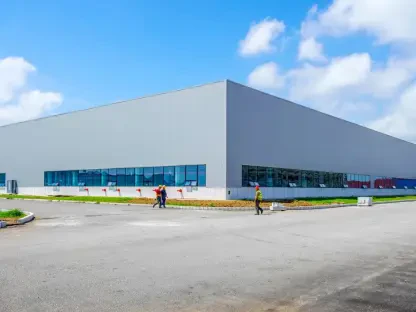The shipping and logistics industry is a complex ecosystem that constantly grapples with challenges like rising costs, geopolitical tensions, and intricate regulatory landscapes. In this evolving scenario, big data emerges as a game-changer. By leveraging vast amounts of data, companies can optimize every aspect of their logistics and supply chain operations, enhancing efficiency and driving innovation.
The Role of Big Data in Modern Logistics
Streamlining Decision-Making Processes
At its core, big data offers real-time insights that are invaluable for decision-making. Companies can analyze data from various touchpoints to improve planning and forecasting. For example, data on customer demand and inventory levels can help businesses make informed choices on procurement and storage. These informed decisions lead to operational efficiency and cost savings. With advanced analytical tools, even small businesses can leverage big data to compete on a global scale.
The capability to interpret large data sets allows businesses to react quickly to market fluctuations and other external variables. Leveraging data analytics, companies can not only anticipate customer needs but also streamline supply chain operations. This results in fewer disruptions and more accurate predictions about future demands. The transparency achieved through big data analytics also enhances communication and coordination among different sectors of a business, contributing significantly to operational harmony and effectiveness.
Enhancing Predictive Analytics
Predictive analytics, powered by big data, allows companies to foresee potential challenges and opportunities. By analyzing historical data, businesses can predict demand surges and market trends, enabling better resource allocation. This predictive capability is crucial for anticipating disruptions and planning accordingly. For example, during peak seasons, companies can ensure they have adequate inventory and shipping capacity to meet customer demands without hitting bottlenecks.
Advanced predictive models can also highlight the potential for disruptions caused by geopolitical tensions or economic shifts. These tools give companies a clear edge in logistical planning, helping them to avoid delays and unnecessary expenses. As data becomes more granular, the precision of these predictions increases, enabling businesses to have contingency plans in place for various scenarios. The forward-looking nature of predictive analytics provides a competitive advantage, amplifying operational readiness and resilience.
Optimizing Shipping Routes
Advanced Route Planning
Big data plays a vital role in route optimization, one of the most complex tasks in logistics. Companies can analyze multiple variables, including vehicle information, GPS data, and weather forecasts, to determine the most efficient routes. This holistic approach reduces transportation costs and minimizes delays. The use of sensor-based data on fuel consumption and driving behaviors can further fine-tune these routes, ensuring cost-efficient and environmentally friendly operations.
Route optimization does more than simply cut down on travel time; it also has profound implications for fuel consumption and vehicle wear and tear. By continuously updating routes based on real-time data, companies can avoid traffic jams, road closures, and other potential delays. This reduces the likelihood of missed delivery windows, bolstering consumer trust and satisfaction. Furthermore, optimized routes contribute to greener logistics practices, decreasing the carbon footprint associated with transportation.
Real-Time Adjustments
With big data, companies can make real-time adjustments to shipping routes. Unexpected delays caused by weather or traffic can be mitigated by instantly rerouting shipments. This agility ensures timely deliveries and enhances overall efficiency. Real-time data also helps in proactive decision-making, allowing logistics managers to address issues before they escalate into significant problems.
Real-time adjustments aren’t just about rerouting vehicles; they also encompass the dynamic management of loading and unloading times. This capability can make the entire supply chain remarkably agile, able to adapt to fluctuating conditions with minimal downtime. For instance, real-time insights into weather patterns can enable logistics managers to anticipate and plan for disruptions, rerouting shipments to avoid potential delays. This adds a layer of resilience that is critical in maintaining service quality and efficiency.
Efficient Inventory Management
Intelligent Stock Control
Effective stock management is essential for meeting market demand and avoiding stockouts. Big data analytics allows companies to monitor inventory levels and order patterns meticulously. By analyzing data from sensors and software systems, businesses can identify trends and optimize stock levels. This proactive approach ensures that companies can respond promptly to market demands, avoiding both overstocking and stockouts.
The intelligent stock control facilitated by big data contributes to more efficient use of storage space, reducing unnecessary costs associated with excess inventory. Companies can better forecast when to reorder products and how much to stock, thereby maintaining optimal inventory levels. Additionally, this kind of precision in inventory management helps in maintaining a lean inventory, reducing carrying costs, and minimizing the risk of obsolescence. This ultimately leads to more agile and cost-effective operations.
Warehouse Optimization
Big data can significantly enhance warehouse management by identifying inefficiencies and bottlenecks. Analytics provide insights into optimal staffing levels and equipment usage, ensuring that warehouse operations run smoothly. Improved warehouse management leads to faster order fulfillment and better customer satisfaction. For instance, big data can help pinpoint underutilized storage space, streamlining operations and reducing unnecessary costs.
Moreover, data-driven insights can inform the layout of a warehouse, optimizing it for streamlined picking, packing, and shipping processes. By analyzing how goods move through a warehouse, companies can rearrange storage to maximize efficiency. Automated systems, powered by big data, can also help adjust staffing requirements in real-time based on order volumes. This adaptability ensures that the warehouse operates at peak efficiency, even during fluctuating demand periods.
Capacity Planning and Risk Management
Predictive Capacity Allocation
Capacity planning is crucial for handling fluctuating demand while minimizing costs. Big data analytics enables companies to predict future resource needs accurately. By analyzing historical trends and market conditions, businesses can optimize the allocation of vehicles, containers, and personnel. This foresight helps in maintaining efficient operations even during peak periods, ensuring that resources are used effectively.
Predictive capacity allocation can be a game-changer in preventing resource shortages and minimizing downtime. By anticipating needs, companies can prepare more effectively for high-demand periods, avoiding the pitfalls of last-minute scrambling. This kind of proactive planning not only saves costs but also improves service levels. Businesses can ensure that they have the right amount of resources in the right places at the right times, thereby enhancing operational efficiency and customer satisfaction.
Risk Mitigation Strategies
Risk management is an integral part of logistics. Big data allows companies to identify potential risks and develop mitigation strategies. By analyzing past data, businesses can anticipate recurring issues and address them proactively. For example, understanding seasonal trends can help in preparing for disruptions caused by adverse weather conditions or supply chain hiccups. This proactive approach minimizes operational risks and enhances overall efficiency.
The ability to foresee and mitigate risks ensures a more resilient supply chain, capable of withstanding various challenges. Through risk assessment models, companies can design strategies to manage supplier reliability, shipment delays, and geopolitical disruptions. Enhanced visibility into these risks allows for timely interventions, preventing minor issues from escalating into major disruptions. In this way, big data acts as an invaluable tool for bolstering the overall stability and reliability of logistics operations.
Improving Customer Experience
Customer Insights
Big data provides valuable insights into customer preferences and behaviors, enabling companies to tailor their offerings accordingly. By analyzing e-commerce data and feedback, businesses can identify pain points and improve their services. This customer-centric approach enhances satisfaction and builds loyalty. Companies can track buying patterns and adjust their strategies to better meet market demands.
Customer insights derived from big data empower businesses to offer more personalized services. By understanding individual customer needs and preferences, companies can customize their marketing campaigns and service offerings, resulting in a more engaging customer experience. Additionally, the ability to foresee purchasing trends allows companies to stock popular items, reducing the likelihood of stockouts and ensuring that customers find what they’re looking for. This level of responsiveness strengthens customer relationships and fosters long-term loyalty.
Transparent Tracking Systems
Transparency in shipment tracking significantly improves customer experience. Big data enables real-time tracking through GPS devices and RFID tags, providing customers with accurate information about their shipments. This transparency builds trust and keeps customers informed about potential delays or issues. Enhanced tracking capabilities lead to better communication and higher customer satisfaction.
In addition to real-time tracking, big data can help companies provide estimated delivery times and update customers proactively about any changes. This level of transparency reduces customer anxiety and enhances their overall experience. Moreover, the ability to track shipments end-to-end helps businesses identify inefficiencies in their delivery processes. By addressing these issues, companies can ensure timely deliveries, thus boosting customer confidence and satisfaction.
Adoption of Advanced Technologies
Integration with AI and IoT
The integration of big data with AI and IoT technologies amplifies its impact on logistics. AI algorithms analyze data more efficiently, providing deeper insights and automating decision-making processes. IoT devices offer real-time data from various touchpoints, creating a connected, responsive logistics network. This synergy between technologies ensures more accurate data analysis and streamlined operations.
Smart sensors and IoT devices collect and transmit a wealth of data that AI systems can analyze to optimize various logistics processes. From predictive maintenance of vehicles to real-time monitoring of shipments, AI and IoT together create a more robust and responsive logistics framework. This kind of interconnected system can foresee issues before they arise and automatically adapt to changing conditions, ensuring smoother, more reliable operations. The integration also facilitates more accurate forecasting and planning, enabling businesses to stay one step ahead.
Automation and Efficiency
Automation, powered by big data, transforms logistics operations by reducing manual interventions and errors. Automated systems can handle repetitive tasks like sorting and routing, freeing up human resources for more strategic functions. This efficiency leads to faster processing times and lower operational costs. For instance, automated systems can quickly adapt to changes in demand, ensuring smooth logistics operations.
As logistics becomes increasingly automated, the role of human workers shifts to more complex, strategic tasks. Automation not only streamlines operations but also ensures higher accuracy by eliminating human error. This precision is particularly crucial in areas like order fulfillment and inventory management, where mistakes can be costly. The efficiency gains from automation allow businesses to scale their operations without a corresponding increase in costs, thereby improving profitability and service levels. This blend of technology and human expertise lays the foundation for a highly efficient and responsive logistics ecosystem.
Conclusion
The shipping and logistics industry is a complex network that constantly faces challenges such as rising costs, geopolitical tensions, and complicated regulatory frameworks. In this dynamic environment, big data is proving to be a revolutionary tool. By harnessing massive amounts of data, companies can fine-tune every aspect of their logistics and supply chain operations. This leads to increased efficiency, reduced costs, and the ability to innovate more rapidly. For example, big data analytics can improve route planning, inventory management, and demand forecasting, cutting down on delays and operational hiccups. Additionally, it offers valuable insights into customer preferences and market trends, helping companies to be more responsive and adaptive. The power of big data lies in its ability to turn raw information into actionable strategies, thereby transforming the logistics landscape. As companies continue to navigate the complexities of the global market, those that effectively use big data will have a significant advantage, setting new standards for efficiency and innovation in the industry.









